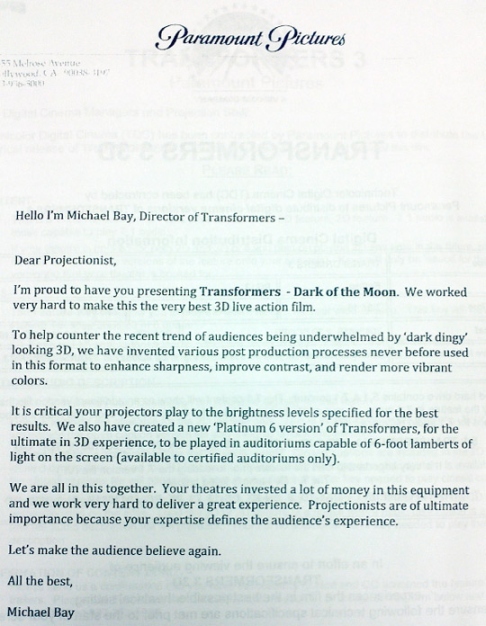The Dark Flaw in 3D's Bright Future:
The figure of 16 foot-lamberts is the standard established by the Society of Motion Picture and Television Engineers for a projector with no film in it.
If you add a 2D film to a projector that meets the brightness standard, you’ll generally wind up with about 14 foot-lamberts, considered an appropriate level of illumination.
3D projection, though, displays two separate pictures, one designed for the left eye, one for the right [...] the immediate result of dividing the picture into two images is that, in Lenny Lipton’s words, “You lose half your light, because half the light goes to one eye and half goes to the other.”
Instantly, a 14-foot-lambert image is reduced to 7.
The glasses used to decode the two images [...] then cut the light further.
“Avatar,” says Lipton, generally screened at about four-and-a-half foot-lamberts; other films are as low as two or three.
“Fourteen foot-lamberts is a decent picture. Half of that, you’re doing fine. But a third of that, you’re kind of getting hairy. And when you get down below three foot-lamberts, you start losing your color vision, and the images are appalling.”
“It can all be solved,” Lipton insists. “The technology is there.”
Michael Bay and 'Transformers 3' shine a light on theater projection:
Michael Bay has been lobbying theater companies to turn up the brightness of their projector bulbs to make Transformers: Dark of the Moon look better in 3-D.
Paramount Pictures has taken the added step of shipping an extra-bright digital “print” of the film to about 2,000 theaters showing it in the RealD 3-D format.
Why would a theater be reluctant to pump up the wattage? It’s because the bulbs can average around $3,200 or run as high as $5,700 and burn out after about 500 screenings, which adds up quickly at a multiplex.

